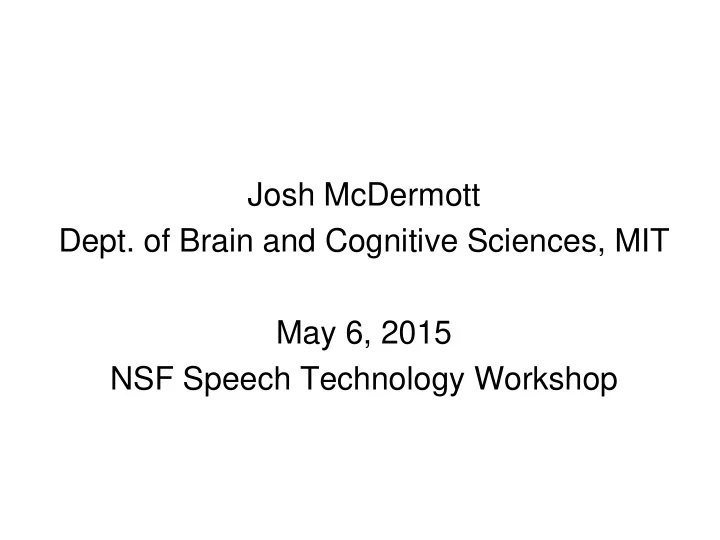

Josh McDermott Dept. of Brain and Cognitive Sciences, MIT May 6, 2015 NSF Speech Technology Workshop
My research group: Laboratory for Computational Audition Psychology Neuroscience Engineering Experiments Auditory Machine in humans neuroscience algorithms • We study auditory scene analysis and sound recognition • Contact with speech technology through assistive devices and machine intelligence • Funded by McDonnell Foundation and NSF
Recent approach in our lab: train deep convolutional neural networks on speech tasks, compare representations to brain • So far: word recognition, speaker identification in noise • CNN performs about as well as humans • Can use CNN as a hypothesis about neural representation
Ability of shallow vs. deep CNN layers to predict brain responses provides insights into computational complexity: Primary auditory cortex Speech- selective cortex shallow deep CNN layer
Using speech analysis/synthesis to manipulate grouping cues: • STRAIGHT decomposes speech into excitation and filtering. • Excitation modeled sinusoidally • Altered to inharmonic, or replaced with noise to simulate whispering: • Do these manipulations affect ability to segregate speech? joint work with Kawahara & Ellis
“WORD 1” Task: “WORD” or Type in all the words you hear. + “WORD 2” 0.9 • Single word recognition 0.8 similar for all conditions. 0.7 • For word pairs, recognition worse for 0.6 Mean # Correct Words inharmonic than 0.5 harmonic speech, suggestive of effect on 0.4 segregation. 0.3 • But much larger effect 0.2 of whispering. Harmonic • Potentially suggestive of 0.1 Jittered Whispered importance of sparsity. 0 Single Word Word Pairs
Reverberation profoundly distorts sound signals: Dry Reverberant Problem for machine speech recognition: Percent Errors Reverberation is also a challenge for hearing- impaired listeners.
Characterizing the distribution of real-world reverberation What is the empirical distribution of environmental impulse responses? IR Measurement • Broadcast fixed source signal • Record resulting reverberant signal • From this, infer environmental IR IR Survey • 24 text messages/day • Phone returns GPS coordinates • Participants reply to text with photo, address
Everyday impulse responses are pretty stereotyped Frequency asymmetry (skew of subband RT60) 6 Survey • Exponential decay KEMAR HATS 5 8m • Faster at high frequencies • Exaggerated asymmetry in 4 271 IRs from 301 large rooms surveyed locations 3 • Suggests prior for dereverberation … 2 1 0 1st quartile 4th quartile -1 -2 -1 0 10 10 10 Mean subband RT60 (s)
Challenges to Impacting Technology • Lack of large high-quality labeled data sets in some domains • Emotional speech • Environmental sounds • Cultural divides between neuroscience and engineering • Different meetings, departments, jargon, funders • Possibly getting worse? • Workshops help, particularly if students have access
Recommend
More recommend